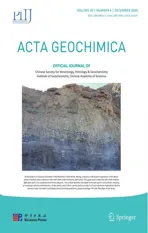In situ LA-ICP-MS analyses of mica and wolframite from the Maoping tungsten deposit, southern Jiangxi, China
2021-01-09GuanghongChenJianfengGaoJianjunLuRongqingZhang
Guanghong Chen · Jianfeng Gao· Jianjun Lu · Rongqing Zhang
Abstract The Maoping tungsten deposit is located in the Nanling W–Sn metallogenic belt in South China. Greisen and quartz vein types of mineralization developed in this deposit.Protolithionite occurs in the granite.Zinnwaldite is occurs mainly in greisen and wolframite–quartz veins whereas phengite is found in the underground quartz veinlets. In granite and greisen, protolithionite, and zinnwaldite are partly replaced by Li-phengite. LA-ICP-MS trace element analyses of micas and wolframite are employed to characterize the ore-forming source and evolution of ore-forming fluids. Micas show compositional variation trend in vertical directions with a decrease of W,Sn, Nb, and Ta and an increase of MgO, V, Ni, and Co.Wolframite in greisen has higher Mo, Sn, Nb, Ta, and REEs than those in quartz veins. All wolframites show similar REE patterns with enrichment of HREE. Wolframites in greisen and quartz veins have negative Eu anomalies, while wolframites in quartz veinlet display positive Eu anomalies. Compositions of mica and wolframite from different mining levels of the Maoping deposit suggest that the ore-forming fluids are dominated by magmatic hydrothermal fluids in the deep with a slight addition of meteoric water in the shallow. Brittle fractureinduced depressurization and fluid mixing controlled the evolution of ore-forming fluids and possibly lead to the wolframite deposition.
Keywords Mica · Wolframite · Magmatic-hydrothermal evolution · In situ analysis · Quartz-vein type W deposit
1 Introduction
Tungsten deposits are widely distributed in South China Block, which accounts for more than 44% of the global W reserves (Mao et al. 2019). They occur as skarn, quartz vein, porphyry, and greisen deposits (Mao et al. 2019).Among them, quartz vein-type tungsten deposits, characterized by a high grade of wolframite, are the most important tungsten sources of the world (Li et al. 2018).The quartz vein-type tungsten deposits are related to granite and are mostly distributed in southern Jiangxi,China. Previous studies have shown that both metals and ore-forming fluids are mainly originated from highly evolved granitic magmas (Mao et al. 2019 and reference therein). However, the evolutionary histories of ore-forming fluids and the process of tungsten mineralization are still not well documented.
Mica is one of the most common rock-forming minerals in granite and wolframite–quartz vein,whereas wolframite is an important tungsten mineral with hydro greisen thermal origins. At the deposit scale, the highest tungsten grades are commonly associated with mica selvages growing into the veins (Jiang 2004; Lecumberri-Sanchez et al. 2017). Micas can accommodate relatively high contents of trace elements due to the layered crystal structure.Therefore, the trace element compositions are easy to be changed with the variations of external conditions and system chemical conditions (Breiter et al. 2019; Legros et al. 2016, 2018; Li et al. 2013; Selby and Creaser 2005;Tischendorf et al. 1997). Wolframite is composed of iron and manganese tungstates. Both iron and tungsten have different valence states so that wolframite can record the geochemical composition of the ore-forming melts and fluids as well as the physico-chemical processes during its precipitate (Harlaux et al. 2018; Zhang et al. 2018).Therefore, micas and wolframite can be used to constrain the evolution processes of granitic systems,including their magmatic-hydrothermal evolution and the concomitant migration and enrichment of ore-forming elements(Breiter et al.2019;Goldmann et al.2013;Tindle and Breaks 2000;Xie et al. 2018).
The Maoping tungsten deposit,discovered in the 1980s,is one of the largest tungsten deposits in China. The Maoping deposit develops greisen types orebodies in the deep and wolframite–quartz vein types orebodies in the shallow. The WO3and Sn reserves for wolframite–quartz vein orebodies are 63,000 and 15,000 t, respectively, with average grades of 0.97% WO3and 0.30% Sn. Greisen orebodies host 40,000 t WO3and 35,000 t Sn with average grades of 0.18% WO3and 0.23% Sn (Hu et al. 2011a).Previous studies have carried on the basic geological characteristics of the Maoping deposit(Huang 1999;Li and Yang 1991),petrology geochemistry of ore-related granites(Zhu et al. 2012), age of granite and tungsten mineralization (Feng et al. 2011), temperature and salinity of orforming fluids (Chen et al. 2018; Hu et al. 2011a) and compositional variation of micas(Legros et al.2016;Tang et al. 2016). Both mica and wolframite are well developed in greisen and wolframite–quartz veins in Maoping, providing a good opportunity to constrain the evolution history of ore-forming fluids by characterizing the vertical variation of mineral compositions.
In this paper, we describe field geology and ore petrography of the Maoping deposit and report in situ analyses of micas and wolframites from different levels at the deposit.A new dataset is used to constrain the evolution of ore-forming fluids and the variation of physico-chemical conditions of magma-hydrothermal system. We demonstrate that ore-forming fluids were mainly magmatic hydrothermal with limited addition of recycled meteoric water in the shallow level. We also discuss the role of the fracture system in the precipitation of wolframite through the comparisons of the composition of mica and wolframite from different levels.
2 Geological setting
The South China Block consists of the Yangtze Block to the northwest and the Cathaysia Block to the southeast(Fig. 1). The amalgamation of Yangtze and Cathaysia blocks along the Jiangshan-Shaoxing Fault is at 1.1–0.83 Ga (Chen and Jahn 1998; Li et al. 2007; Shui 1988;Wang et al.2007;Xia et al.2018;Zhao et al.2011).The Cathaysia Block underwent extensively reworking during Caledonian, Indosinian to Yanshanian tectonicthermal events (Yuan et al. 2018).
The Cathaysia Block is mainly composed of metamorphic basement of Precambrian–Ordovician lower greenschist facies clastic rocks and a cover of Devonian–Permian shallow marine carbonate and siliclastic sedimentary rocks. Jurassic-Quaternary terrigenous red-bed sandstones and volcaniclastics series are exposed in the region (Feng et al. 2011; Yuan et al. 2018). Silurian and Triassic strata are lacked in the region.
Mafic to felsic pluton and volcanic rocks with ages from Neoproterozoic to Cenozoic are widely distributed in the Cathaysia Block. Most plutons and volcanic rocks range are 190–80 Ma due to the subduction of the Paleo-Pacific Plate underneath the South China Block (Zhou and Li 2000; Zhou et al. 2006). Most of the tungsten and tin deposits are spatially and genetically associated with highly evolved Mesozoic granitic rocks (Mao et al. 2019 and reference therein).
The Nanling Range is in the central part of the Cathaysia Block (Fig. 1). There are several mainly regional faults closely related to the evolution of the Nanling Range,including the Pingxiang–Guilin, Longyan–Haifeng, Ganjiang–Sihui–Wuchuan faults. These regional faults control the distribution, scale, and occurrence of Mesozoic and Cenozoic igneous rocks and sedimentary basins (Shu et al.2006). The Nanling Range hosts 8 large deposits, 24 medium deposits, and 46 small deposits (Fig. 2), among which a total reserve of WO3is 1.7 Mt in southern Jiangxi Province (Zeng et al. 2007). Most tungsten deposits in southern Jiangxi province are quartz-vein type (Wei et al.2012). The majority of the large- and medium-sized ore deposits or occurrences are distributed in four ore clusters(Chongyi–Dayu–Shangyou, Ganxian–Yudu, Sannan(Longnan–Dingnan–Quannan) and Xingguo–Ningdu)(Fig. 2)(Feng et al.2011).The Maoping deposit is located in the Chongyi–Dayu–Shangyou ore cluster.
3 Deposit geology
In the Maoping mining district, the dominant strata are the Middle and Lower Cambrian metamorphosed sandstone and slate (Figs. 3, 4). Tungsten mineralization at the Maoping deposit is mainly controlled by folds and faults.The fold structures include the Upper and Lower Maoping homoclines and the Shenfuxi–Gaoqiaoxia anticline(Fig. 3). The ore-controlling faults mainly strike E–W and dip S or N at 50°–75°. Two post-mineralization fracture zones strike NE and NW along reverse faults (Fig. 3) (Li and Yang 1991). According to the distribution and occurrence of the ore veins, the Maoping deposit could be subdivided into three segments: Xiamaoping, Shangmaoping,and Gaoqiaoxia segments from north to south (Figs. 3, 4).
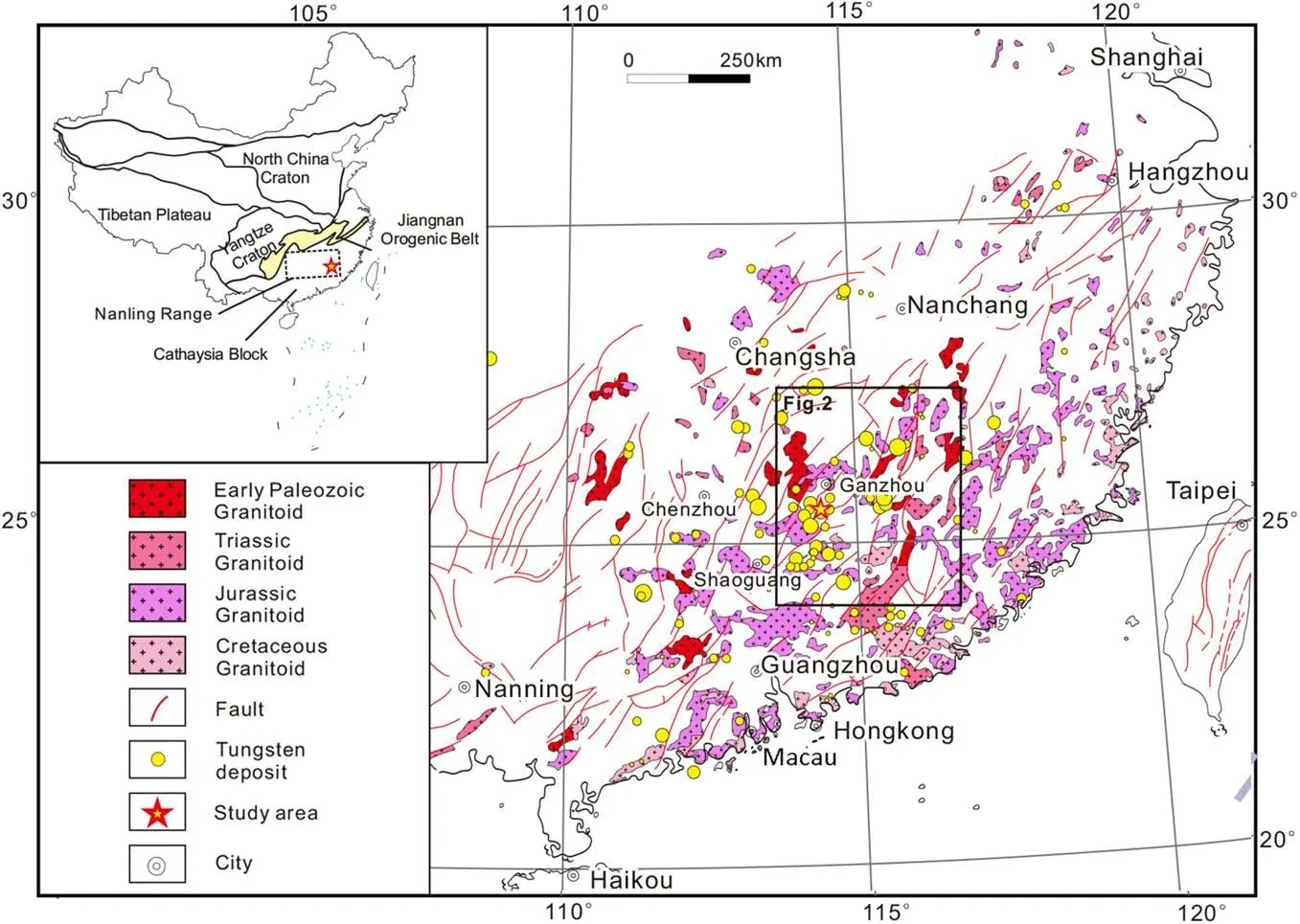
Fig. 1 Distribution and mineralization type of major tungsten deposits in South China (modified after Mao et al. 2013)
The Maoping deposit is located to the north of the Middle Jurassic Tianmenshan peraluminous granite intrusion. A buried granitic pluton, the extension of the Tianmenshan granite, is associated with the wolframite–quartz veins in the mining area (Huang 1999). The buried pluton includes porphyritic biotite granite and fine-grained muscovite granite. SHRIMP U–Pb dating on zircon show that the porphyritic biotite granite was emplaced at 151.8 ± 2.9 Ma (Feng et al. 2011).
The mineralization types at the Maoping deposit are dominated by wolframite–quartz vein type and greisentype (Fig. 4). There are more than 400 wolframite–quartz veins which are commonly 300–500 m long and 5–100 cm thick.The vein groups of three segments all intersect in the top of the buried granite pluton,the greisen-type orebodies,pegmatite shell, and metamorphic rocks in the exocontact(Fig. 5a, b). There is a layer of pegmatite shell at the junction between the top of granite and slate. The pegmatite shell is mainly composed of quartz and mica,which is spider-like or serrated (Fig. 5c). Ore minerals in quartzvein (Fig. 5d) and quartz-veinlets (Fig. 5e) include wolframite, cassiterite, molybdenite, sphalerite, chalcopyrite,bismuth,native bismuth,while gangue minerals are mainly quartz, mica, fluorite, and topaz.
The greisen type orebodies have a layer-like form and range from the top of the buried granite intrusion which is at - 5 m down to - 200 m. Ore minerals in greisen are mainly wolframite, cassiterite, molybdenite, bismuth, uraninite, and xenotime, whereas gangue minerals include quartz, mica, albite, and fluorite.
4 Mineralogy
4.1 Mica
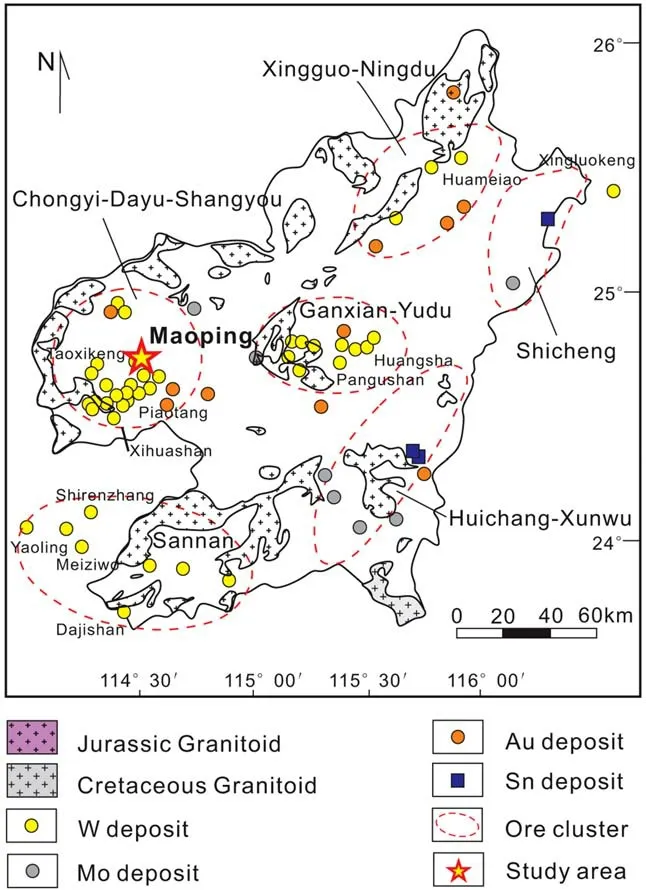
Fig. 2 Distribution of major tungsten deposits and granites in southern Jiangxi Province (modified after Huang et al. 2014)
Micas from granite are mainly subhedral protolithionite(Fig. 6a, b). The protolithionite is partly altered by Liphengite(Fig. 6b). Micas of greisen consist of zinnwaldite and Li-phengite (Fig. 6c, d), which are alteration products of the granite.The mica shell in wolframite–quartz veins is dominant by zinnwaldite (Fig. 6e, f), which are metasomatic and altered by Li-phengite along the rim and fractures(Fig. 6f).The width of zinnwaldite shell is from 0.1 to 10 cm.In the shallow part of the quartz veins,mica is small with a width of mica shell in the veinlets of the ground surface of 0.1–0.3 cm.
There are two types of micas in quartz veinlets according to the BSE image under SEM.The mica with the dark domain is close to the metamorphosed sandstone,while the mica with the light domain is associated with quartz. Some mica in the veinlets has experienced chloritization.
4.2 Wolframite
The wolframite of the Maoping deposit could be classified into two types according to the occurrence of mineralization type: greisen (Fig. 7a, b) and wolframite–quartz vein (Fig. 7c–f). Wolframite grains in greisen is enhedral to subhedral with grain sizes <100 μm. Some wolframite grains in greisen display distinct cathode luminescence domains under SEM (Fig. 7b): the inner dark domain and the outer light domain. In some grains, the light domain form rim overgrowth of the inner dark domain.Wolframite in quartz veins is bigger (up to several cm) than that in greisen. Most wolframite grains show homogeneous texture under the microscope and SEM (Fig. 7d, f).
5 Sampling and analytical methods
5.1 Sampling
Coexisting micas and wolframite were collected at different levels of mines which include the veinlet at ground surface (309 m), quartz veins of 40, - 5, - 30, - 52,- 75, - 100 m level, granite and greisen. The samples of wolframite–quartz veinlets and veins are hosted in sandstone or slate. The sampled fine-grained biotite granite has undergone a little greisenization was picked from drill hole rang from - 29.7 to - 40.1 m (drill hole: ZK30015).
5.2 Analytical methods
Back-scattered electron (BSE) images of mica and wolframite were taken with a Carl Zeiss Supra 55 field-emission scanning electron microscope (FE-SEM) coupled to a GATAN MonoCL4 detector at the State Key Laboratory for Mineral Deposits Research in Nanjing University,China. The analysis conditions were an accelerating voltage of 15 kV, a working distance of 8.5 mm, and an aperture size of 60 μm.
Quantitative chemical analyses of wolframite and micas were obtained on polished thin sections using a JEOL JXA-8100M electron microprobe (EMPA) at the State Key Laboratory for Mineral Deposits Research at Nanjing University, China. The operating conditions were set at a probe current of 20 nA, an acceleration voltage of 15 kV for all elements, and a beam diameter of 10 μm for micas and 1 μm for wolframite.The precisions of the analyses are better than 5% for major elemental (>1 wt%).
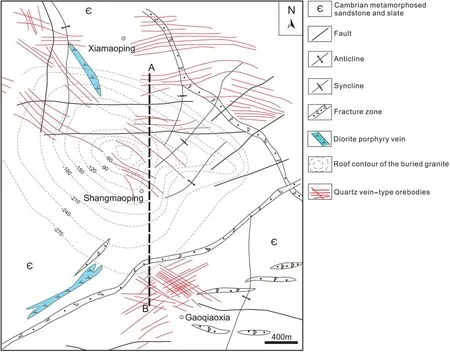
Fig. 3 Schematic geological map of the Maoping tungsten deposit (modified after Chen et al. 2018; No. 2 team of Jiangxi Nonferrous Geological Prospecting 1989)
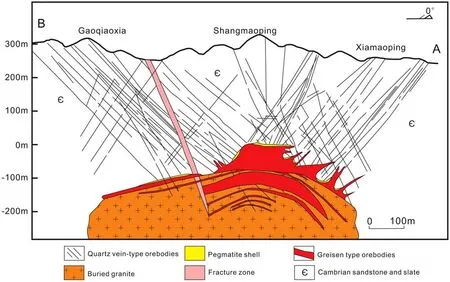
Fig. 4 Cross section of the Maoping tungsten deposit (a,b in Fig. 3) (modified after Chen et al. 2018)
In situ analyses of wolframite and micas in thin sections were conducted by LA-ICP-MS at Nanjing FocuMS Technology Co. Ltd. Cetac Photon Machines Analyte Excite 193 nm laser-ablation system (Bozeman, Montana,USA) and Agilent Technologies 7700 × quadrupole ICPMS (Hachioji, Tokyo, Japan) were combined for the experiment. The 193 nm ArF excimer laser, homogenized by a set of beam delivery systems, was focused on wolframite and micas surface with a fluence of 6.0 J/cm2.Ablation protocol employed a spot diameter of 40 μm at a 7 Hz repetition rate for 40 s. Helium was applied as a carrier gas to efficiently transport aerosol to ICP-MS. 47 elements were measured by7Li,25Mg,27Al,29Si,44Ca,45Sc,49Ti,51V,53Cr,55Mn,57Fe,59Co,60Ni,85Rb,88Sr,89Y,90Zr,93Nb,95Mo,118Sn,133Cs,137Ba,139La,140Ce,141Pr,146Nd,147Sm,151Eu,155Gd,159Tb,163Dy,165Ho,167Er,169Tm,173Yb,175Lu,178Hf,181Ta,182W,208Pb,232Th and238U. United States Geological Survey basaltic glasses,including BIR-1G,BHVO-2G,BCR-2G,and GSE-1G,were used as external calibration standards as these are of a similar matrix as anhydrous silicate (Gao et al. 2013).Raw data reduction was performed off-line by ICPMSDataCal software using a 100 %-normalization strategy without applying internal standard (Liu et al. 2008). Chinese Geological Standard Glasses CGSG-1, CGSG-2,CGSG-4, CGSG-5 (prepared by the National Research Center for Geoanalysis, Beijing, China) were treated as quality control (Hu et al. 2011b). Analytical precision is estimated to be better than 10% of the replication of standard materials.
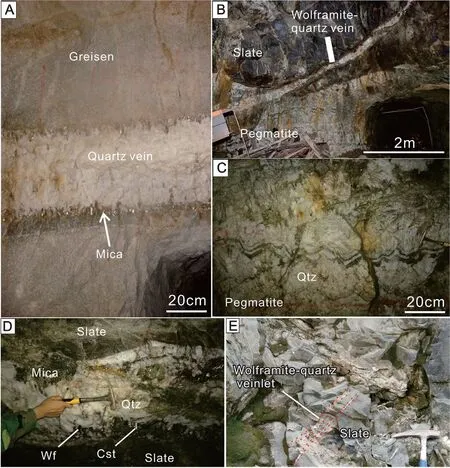
Fig. 5 a Wolframite quartz vein cut greisen,b contact relationship of wolframite quartz vein,pegmatite shell and slate,c The mica and quartz of pegmatite is spider-like, d wolframite–quartz vein (40 m) showing the occurrence of mica shell, and disseminated wolframite and cassiterite,e wolframite–quartz veinlet in the ground (309 m); mineral abbreviations: Wf wolframite, Cst cassiterite, Qtz quartz
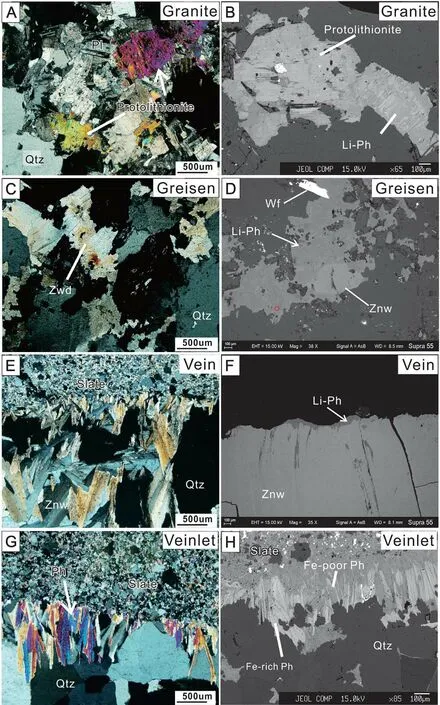
Fig. 6 a Microphotograph of protolithionite in granite,b BSE images showing that protolithionite in granite was replaced by Li phengite,c photograph of zinnwaldite in greisen, d BSE image showing that zinnwaldite in greisen was altered to Li phengite, e microphotograph of zinnwaldite in veins at- 75 m level,f BSE images of zinnwaldite in quartz vein,rim and fracture of zinnwaldite has been replaced by Li phengite, g microphotograph of phengite in veinlet (309 m), h BSE image showing the spatial relationship of Fe-poor phengite and Fe rich phengite (309 m). Mineral abbreviations: Li Ph Li phengite, Wf wolframite, Znw zinnwaldite, Qtz quartz, Pl plagioclase
The Li2O contents can be tested accurately by LA-ICPMS. The Li2O contents were also estimated using SiO2regression for the dominantly trioctahedral micas (Li2-O = 0.287 × SiO2-9.552) and F regression for the dominantly dioctahedral micas(Li2O = 0.31134 × F-0.075895)according to the empirical methods proposed by Monier and Robert (1986) and Tischendorf et al. (1997). A good positive linear correlation exists between Li determined by LA-ICP-MS and F or SiO2determined by EMPA for micas.
6 Results
6.1 Mica
Major and trace element compositions of micas from different levels are summarized in Tables 1 and 2,respectively.
Micas of the Maoping deposit can be classified into four types according to the geological occurrence, texture, and chemical composition (Fig. 8) (c.f. Tischendorf et al.1997). The micas of granite from Legros et al. (2016) are plotted in protolithionite field while micas from granite in this study include Li-phengite and protolithionite.Micas in greisen are mainly zinnwaldite with alteration products of Li-phengite,whereas micas in wolframite–quartz veins are zinnwaldite. Micas in the veinlet of ground are plotted in phengite domain, which could be subdivided into two subtypes,including Fe-poor phengite and Fe-rich phengite.
Micas in granite, including protolithionite and Liphengite,have relatively high F,Li,W,Sn,Nb,Ta,Sc and relatively low Mo, Co, Ni, and V (Tables 1, 2). Fluorine contents of protolithionite(average = 4.12 wt%)are higher than those of Li-phengite (average = 2.98 wt%) (Table 1;Fig. 9). Micas in greisen have a relatively high F, Li, W,Sn, Nb, Ta, and relatively low Co, Ni, Ti, V, and Sc. The Li-phengite is richer in W but poorer in Li,Nb,and Ta than the zinnwaldite (Fig. 9). Fluorine contents of zinnwaldite(average of 6.32 wt%) are higher than the Li-phengite(average of 3.92 wt%). The zinnwaldite of wolframite–quartz vein (from 40 to - 100 m) has a relatively high content of FeO,MnO,MgO,Li2O,Sn,Nb,Ta,Mo,Co,Ni,V,and Sc.The F content of zinnwaldite range from 4.87 to 7.25 wt% with an average of 6.37 wt%. The phengite in wolframite–quartz veinlet in the ground (309 m) has relatively high contents of MgO, Co, Ni, Ti, V, and relatively low contents of FeO, MnO, Li2O, W, Sn, Nb, Ta, Mo, Sc and Zn. The Fe-rich phengite is richer in FeO, MgO, and Li2O than the Fe-poor phengite. The F content of Fe-poor phengite (average 3.04 wt%) is lower than the Fe-rich phengite (average 5.44 wt%).
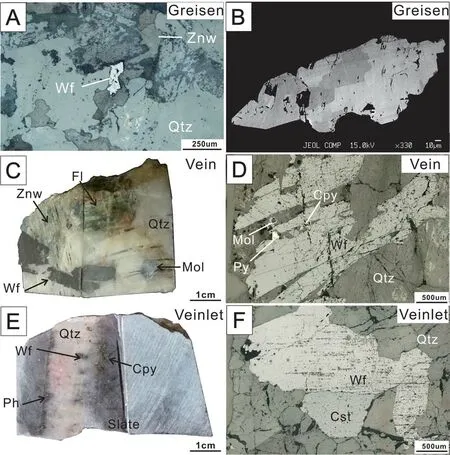
Fig. 7 a Microphotograph of wolframite in greisen,b backscattered electron images of wolframite showing the overgrowth of light domain around the inner dark domain,c photograph of wolframite–quartz vein (- 30 m),d microphotograph of mineral association of wolframite–quartz vein (- 30 m),e photograph of wolframite of wolframite–quartz veinlet(309 m), f microphotograph of wolframite of wolframite–quartz veinlet (309 m). Mineral abbreviations: Wf wolframite,Cst cassiterite, Mol molybdenite, Py pyrite, Cpy chalcopyrite, Fl fluorite, Znw zinnwaldite, Qtz quartz
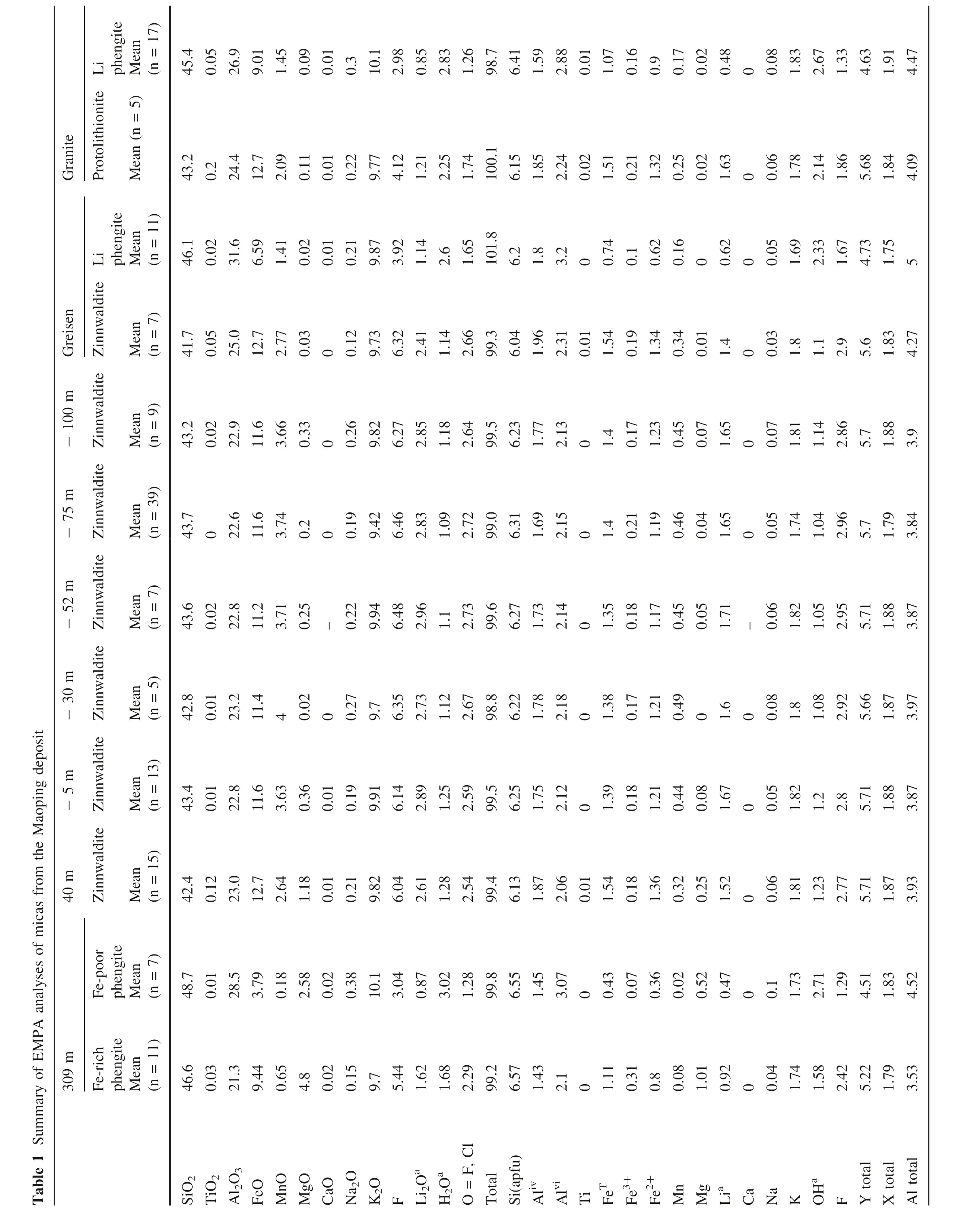

6.2 Wolframite
Chemical compositions of wolframite from different levels determined by EPMA and LA-ICP-MS are summarized in Table 3. MnO/FeO ratios of wolframite from greisen 0.74 to 1.08, while MnO/FeO ratios of wolframite from quartz veins and veinlets range from 0.63 to 3.82 (Fig. 10). The Fe/(Fe + Mn) ratios of wolframite in Maoping have two clusters. The Fe/(Fe + Mn) ratios of wolframite in 309 m(0.45–0.61), - 52 m (0.37–0.54) and greisen (0.48–0.57)are close to 0.5. But Wolframite from 40 m (0.29–0.38),- 5 m (0.21–0.24), - 30 m (0.22–0.31), - 75 m(0.21–0.31) and - 100 m (0.24–0.27) are close to the huebnerite endmember.
The wolframites show a geochemical variation for some elements with depth (Fig. 10). The rare metal contents in wolframite increase with depth for Nb (from 44.6 to 11,660 ppm),Ta(from 0.20 to 24,249 ppm),Sn(from 0.80 to 899 ppm), Mo (from 3.4 to 783 ppm). But some elements contents in wolframite decrease with depth for MgO(from 0.09 to 0.01 wt%), Co (from 4.5 to 0.01 ppm), V(from 9.1 to 0.01 ppm), Ti (from 551 to 1.3 ppm).
Wolframites in greisen and quartz vein display similar chondrite-normalizedREE(REEN)patterns(HREE-enriched)(Fig. 11).Wolframite in greisen has significantly negative Eu anomalies (δEu: average 0.001) (Table 3), whereas wolframite in quartz vein shows relatively weak negative Eu anomalies (δEu = 0.001–0.095, average = 0.016). wolframites in the veinlet (309 m level) even show positive Eu anomalies(δEu:0.23–6.41,average 1.27)(Fig. 11h).Besides,the content of REE of wolframite in greisen (average∑REE = 2523 ppm) is much higher than wolframite in quartz veins (average ∑REE = 210 ppm). Wolframite in quartz veinlets of 309 m level has the lowest ∑REE with an average of 12.7 ppm.On the whole,the content of the REE of wolframite increases gradually with depth.
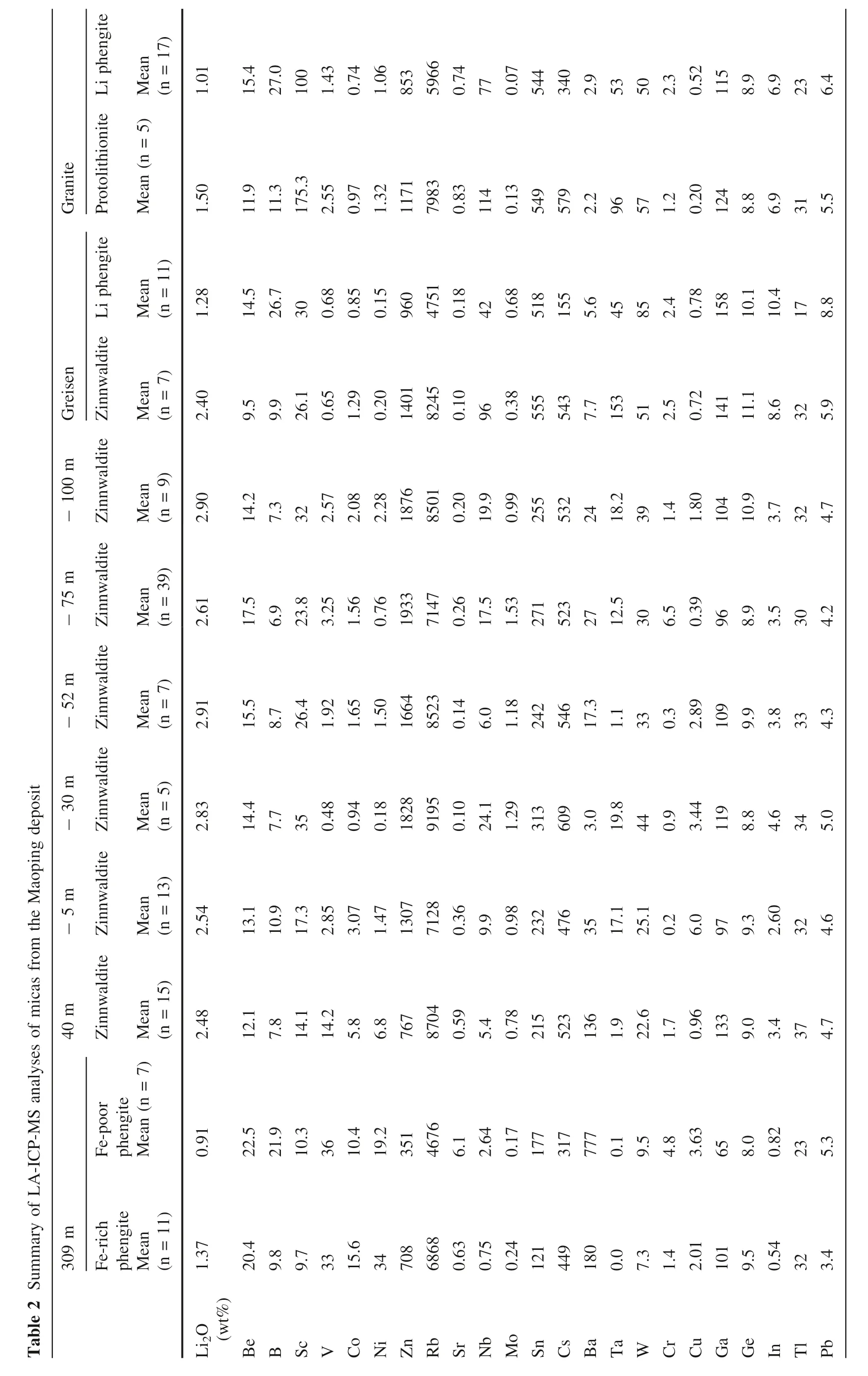
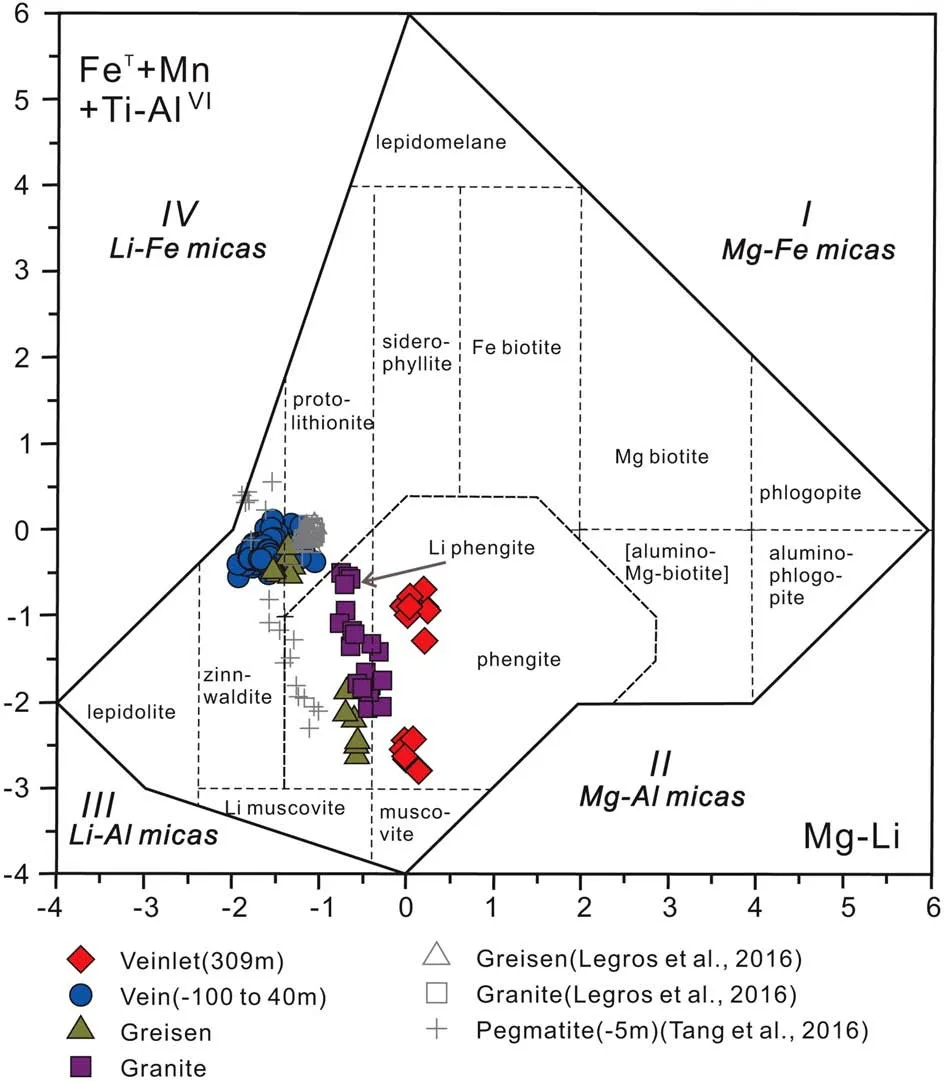
Fig. 8 Compositions of micas showed in the Tischendorf et al.(1997) discrimination diagram of Fe + Mn + Ti–Al VI versus Mg–Li
Some wolframite grains of greisen is inhomogeneous.The CL-dark wolframite has lower REE (∑REE = 1900 ppm) and higher Nb (5899 ppm) and Ta (8194 ppm) than the CL-light zone (∑REE = 2372 ppm, Nb = 4033 ppm,Ta = 5481 ppm).
7 Discussion
7.1 Magmatic origin of ore-forming fluids
Micas and wolframite are common minerals in tungsten deposits. The compositions, especially the trace elements,can trace the source of fluids from which they precipitate.Zinnwaldites in greisen, have high W, Sn, Nb, Ta, similar as protolithionite in granite (Table 2; Fig. 9), which indicates that the zinnwaldite in greisen is of magmatic hydrothermal origin. Although micas in wolframite–quartz veins have highly variable W,Sn,Nb,and Ta,most micas,particularly micas at deep levels(<-50 m),have high W,Sn,Nb,and Ta.Nb and Ta are commonly enriched in hightemperature fluids and decrease with temperature decline(Liu and Cao 1987). High contents of Nb and Ta in wolframite possibly indicate that ore-forming fluids were originated from granitic magma (Harlaux et al. 2018).Therefore, ore-forming fluids are likely to be enriched in rare metals (such as W, Sn, Nb, Ta, etc.), supporting that the ore-forming fluids are dominated by magmatic-hydrothermal fluids.
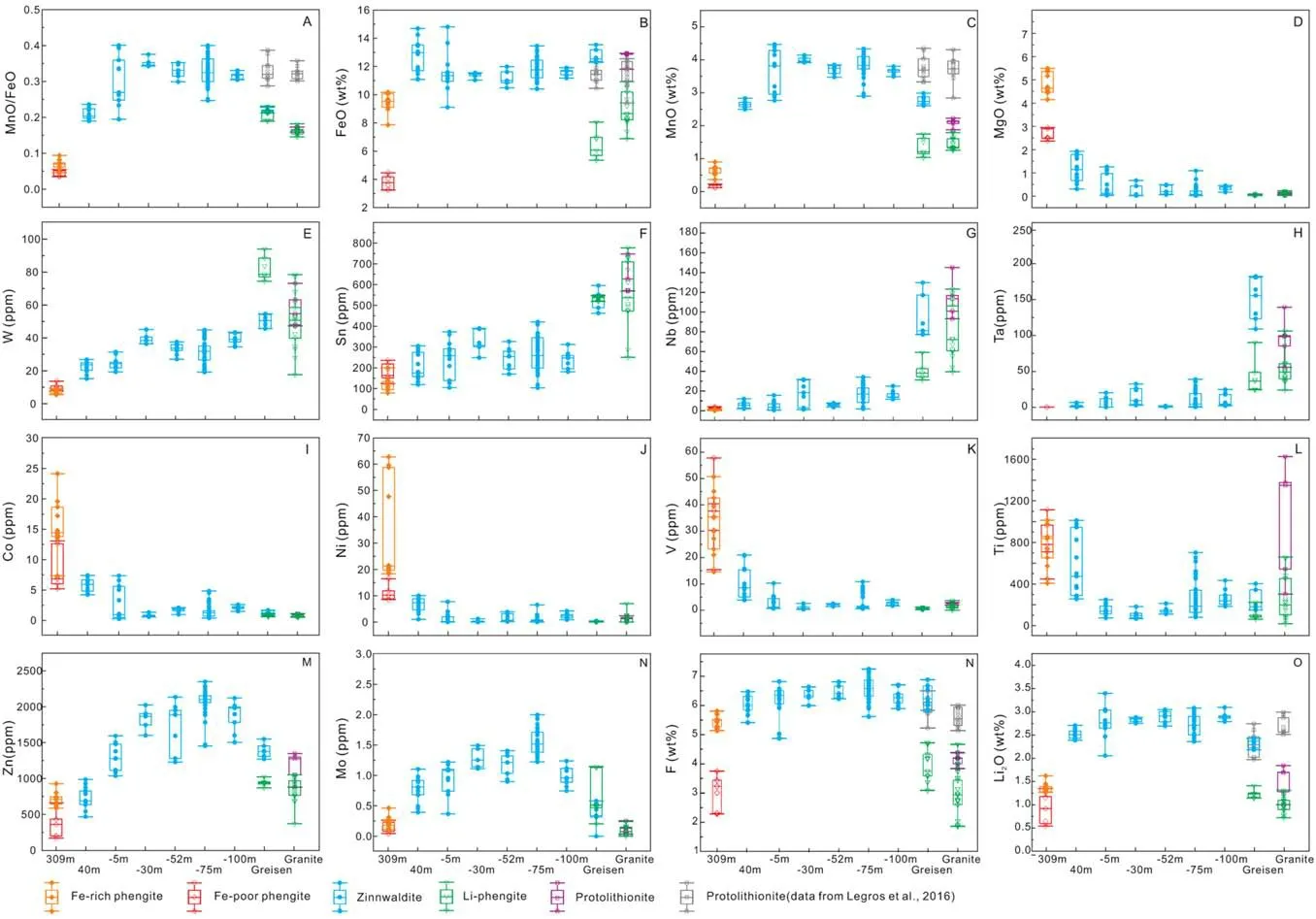
Fig. 9 Variation diagram of major and trace elements of mica in different levels of the Maoping deposit
Micas have very low REE contents so that REE patterns of hydrothermal micas cannot be used to trace the source of ore-forming fluids. Heavy REEs (HREEs) have ionic radii closer to Fe2+and Mn2+than light REEs (LREEs)(Shannon 1976). Thus, the partition coefficient between wolframite and ore-forming fluids of HREE would be much larger than those of LREE. Due to the lack of a partition coefficient of each element in wolframite, REE patterns of wolframite could not be directly used to constrain the REE composition of fluids. Wolframite grains in quartz-veins have similar REE patterns to those in greisen at the Maoping deposit (Fig. 12), showing the deletion of LREE and significantly negative Eu anomalies.The unique REE patterns, together with elevated Nb and Ta contents,indicate that wolframite in Maoping have a similar origin as those from the Xihuashan and Piaotang W deposits(Zhang et al. 2018), but different from those of low-temperature Woxi Au–Sb–W deposit (Zhu et al. 2014),indicative of the high-temperature magma-derived origin.Although wolframite in greisen and wolframite–quartz vein and veinlet have different REE concentrations and show different LREE-depleted REENpatterns, they both have significantly negative Eu anomalies, similar to those of the granite(Fig. 11).Thus,negative Eu anomalies of the wolframite are likely inherited from the highly fractionated granite (c.f. Zhang et al. 2018).
Chen et al.(2018)reported oxygen isotope compositions of quartz and wolframite in the Maoping W deposit.Quartz in wolframite–quartz veins of zone III, IV and V (corresponding to the levels <-50 m) in Maoping has δ18O values from 12.0 to 14.3 ‰, corresponding to the δ18O values of ore-forming fluids of 5.0 to 7.2 ‰ (Chen et al.2018). In contrast, wolframite has δ18O values range from 4.1 to 6.0 ‰, corresponding to the δ18O values of oreforming fluid from 6.1 to 8.0 ‰. Both wolframite and quartz have oxygen isotopic compositions plotted in the magmatic water field,also support the magmatic origin for ore-forming fluids.
7.2 Evolution of ore-forming fluids and possible controls
Tungsten and Sn in mica and Sn in wolframite show continuously decreasing trend from the deep to shallow(Figs. 9,10).Due to a lack of partition coefficient of W and Sn between mica and hydrothermal fluids, variations of contents of W and Sn in mica are assumed to represent the changing of W and Sn in ore-forming fluids. Precipitationof wolframite suggests that W is saturated in ore-forming fluids so that W contents in mica could be used as an indicator for the solubility of W in fluids.
Together they formed Hands Across America- It Starts with You -an organization that encourages the public to learn sign language and has started making educational videos that use both deaf and hearing children together.
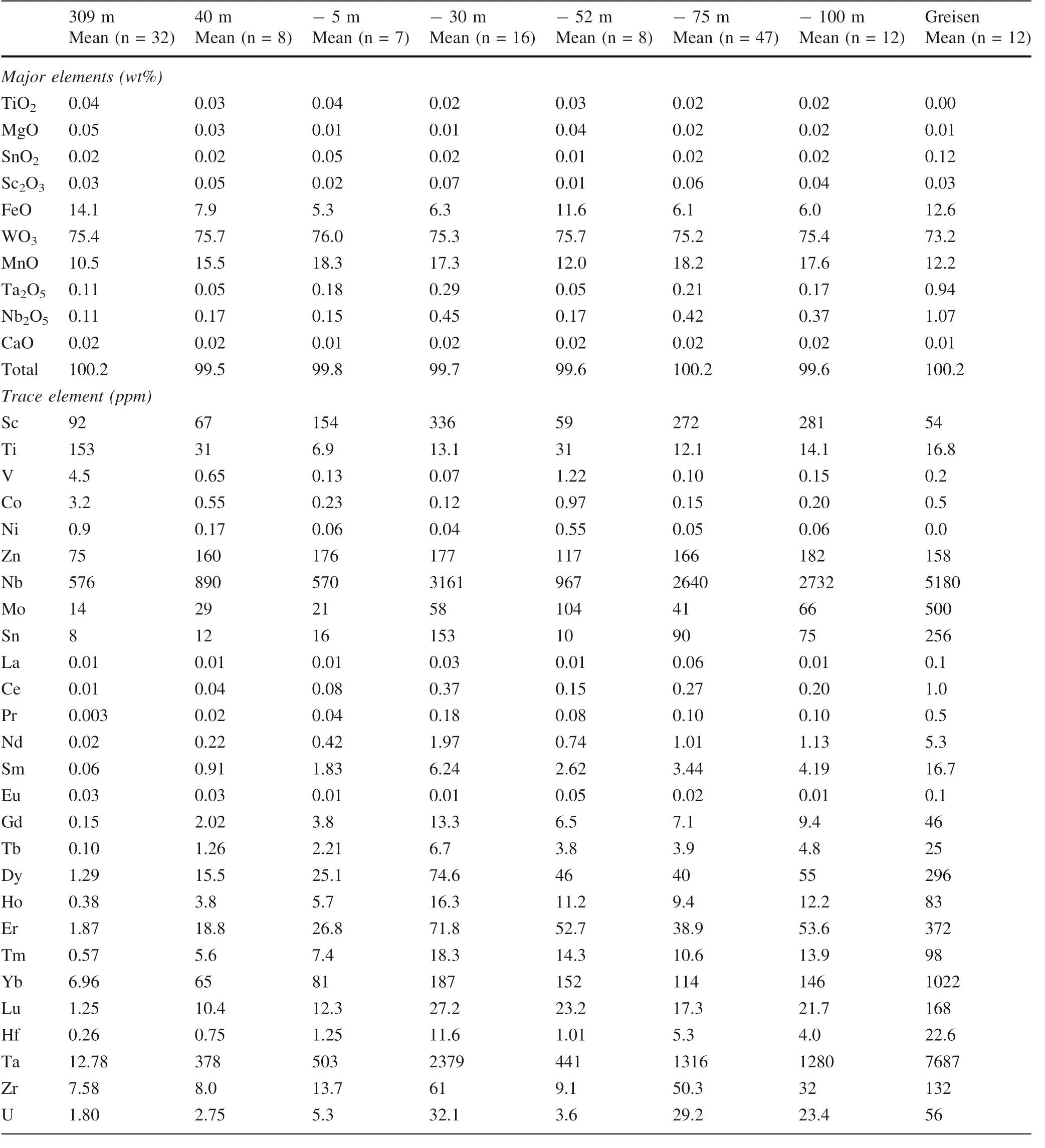
Table 3 Summary of major and trace elements of wolframite from the Maoping W deposit
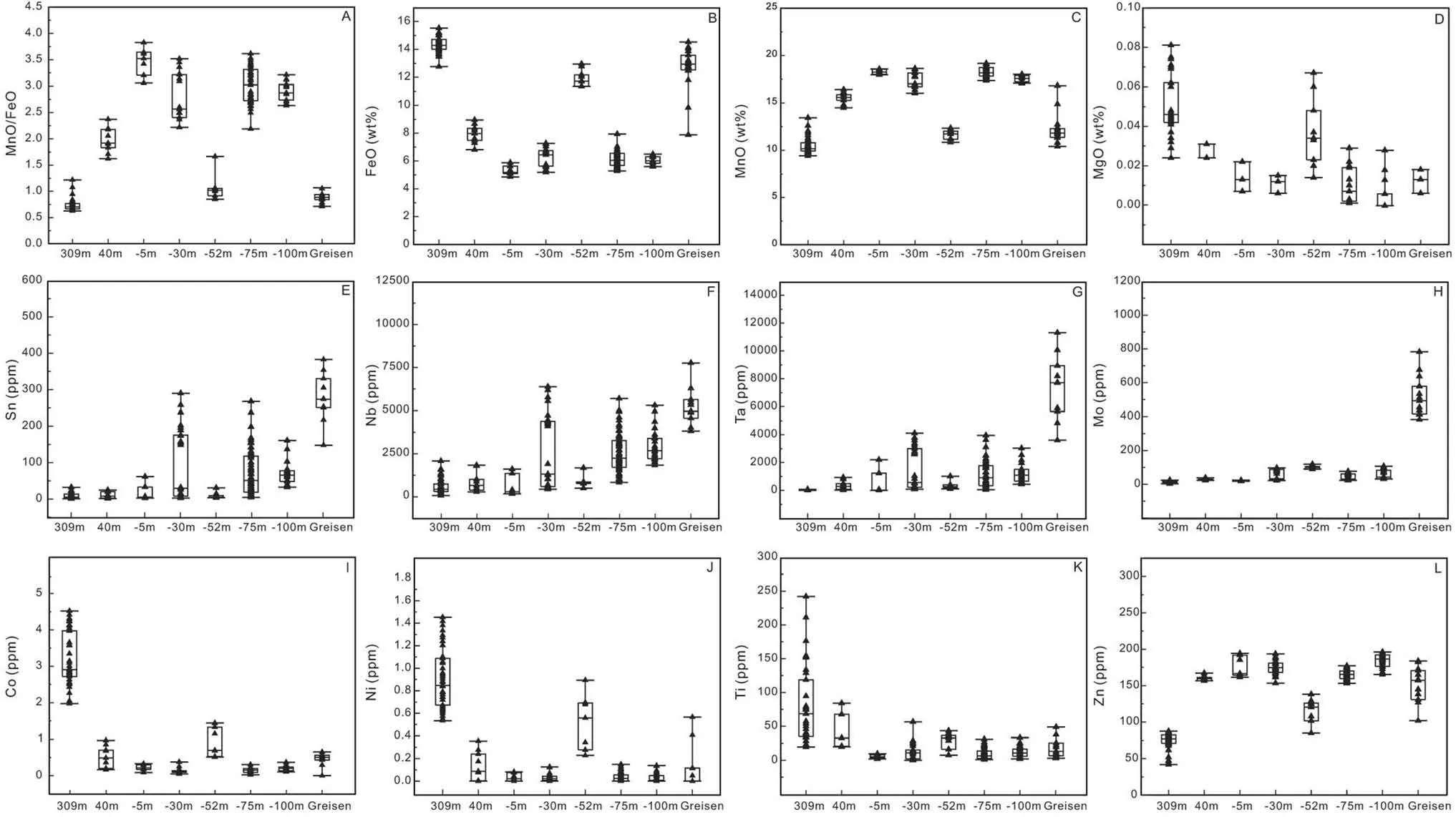
Fig. 10 Variation diagram of major and trace elements of wolframite in different levels of the Maoping deposit
Tungsten is thought to be transported in hydrothermal fluids as WO42-, which is complexed with Na+, K+, Li+,and H+(Wood and Samson 2000). Micas from greisen to 40 m mining level have nearly constant Li2O (Fig. 9)suggesting that destablitiy of Li(Na)–W complex does not play an important role in decreasing the solubility of W in fluids. Thus, the solubility of W in hydrothermal fluids is mainly controlled by the pH values (Wood and Samson 2000) and temperature (Heinrich 1990; Wang et al. 2020).The loss of CO2could increase pH value of fluids and thus affect the transportation of W.CO2-bearing fluid inclusions are commonly observed in quartz but rarely presented in wolframite, precluding the function of CO2in W transportation and deposition (Ni et al. 2015). In addition, the presence of muscovite in quartz-veins and nearly constant F contents in micas suggest that wolframite precipitation was not triggered by a strong increase of pH values(Michaud and Pichavant 2019). Thus, temperature decline is probably the main control of wolframite crystallization(c.f. Heinrich 1990).
Greisen is usually considered to be a product of high-T alteration (Pirajno 1992; Shcherba 1970). With the decreasing of temperature and pressure, the ore-forming fluids escape and fill the fractures in surrounding country rocks forming quartz-veins (Pirajno 2009). In Maoping,fluid inclusions in the wolframite–quartz vein are thought to show a slightly continuous decrease of homogenization temperature from deep to shallow (Chen et al. 2018).However, fluid inclusions in wolframite and quartz have similar homogenization temperature and salinity, suggesting that temperature variation of ore-forming fluids at these mining levels is not distinct. Both Nb and Ta are sensitive to temperature(Harlaux et al.2018),wolframite and micas from- 100 to 40 m mining levels have similar Nb and Ta contents (Figs. 9, 10), supporting relatively constant temperature of fluids at such levels. Therefore, the decreasing temperature of fluids took place before the fluids enter the fractures where ore-forming fluids have a nearly constant temperature. In comparison, micas and wolframite from veinlets at 309 m level have the lowest Nb and Ta contents.Fluid inclusions in this level also have the lowest homogenization temperature,indicating the cooling of ore-forming fluids at a shallow level.
Wolframite from different levels of the Maoping deposit show a gradually decreasing trend in REE contents.Despite different REE concentrations of wolframite from variable levels, wolframite from the greisen, quartz vein and quartz veinlet have similar REE patterns.The previous study of wolframite from the Xihuashan and Piaotang deposits have shown that precipitation of wolframite would reduce the REE contents of the ore-forming fluid but would not change their REE patterns (Zhang et al. 2018).Therefore, the decrease of REE in wolframite in levels from the deep upwards indicates the evolvement of the oreforming fluids. Europium has two different valences:2 + and 3 +. The Eu3+is easier to enter into wolframite lattice than Eu2+according to the ionic radius so that the increase of oxygen fugacity would result in elevated Eu3+/Eu2+ratios in fluids and thus relatively high EuN/Eu*ratios in wolframite. In the Maoping deposit, wolframites of both greisen and wolframite–quartz vein have the negative Eu anomalies, while wolframites in quartz veinlet from the 309 m level have positive Eu anomalies,suggesting that fluids are relatively reduced in the deep(<40 m level) but relatively oxidized at 309 m level. The negative Eu anomalies of wolframite in greisen may be inherited from the magma, while wolframite in quartz veinlets at 309 m level may indicate relatively the oxidized nature of ore-forming fluids. The drastic changing of oxygen fugacity might be caused by the addition of meteoric water in the shallow of the mineralization system,which is supported by the oxygen isotopes of wolframite and quartz(Chen et al.2018).The similar variations of Eu anomalies in wolframite could be found in other tungsten deposits in Southern Jiangxi, such as Piaotang and Dawangshan(Lin 1988;Zhang et al.2018),indicating that redox conditions of hydrothermal systems in the shallow level in the quartz-vein type tungsten mineralization would have been changed. The Fe3+/(Fe3++ Fe2+) ratio of mica can also record the variation of oxygen fugacity of fluids from which it precipitated (Li et al. 2013). From granite and greisen to the wolframite–quartz veins, Fe3+/(Fe3+-+ Fe2+) ratios show the slightly decreasing trend, suggesting that the oxygen fugacity of ore-forming fluids is slowly lowering. The relatively reduced nature of fluids will be conducive to the formation of wolframite (Huang et al. 2014; Lecumberri-Sanchez et al. 2017; Li et al.2013).
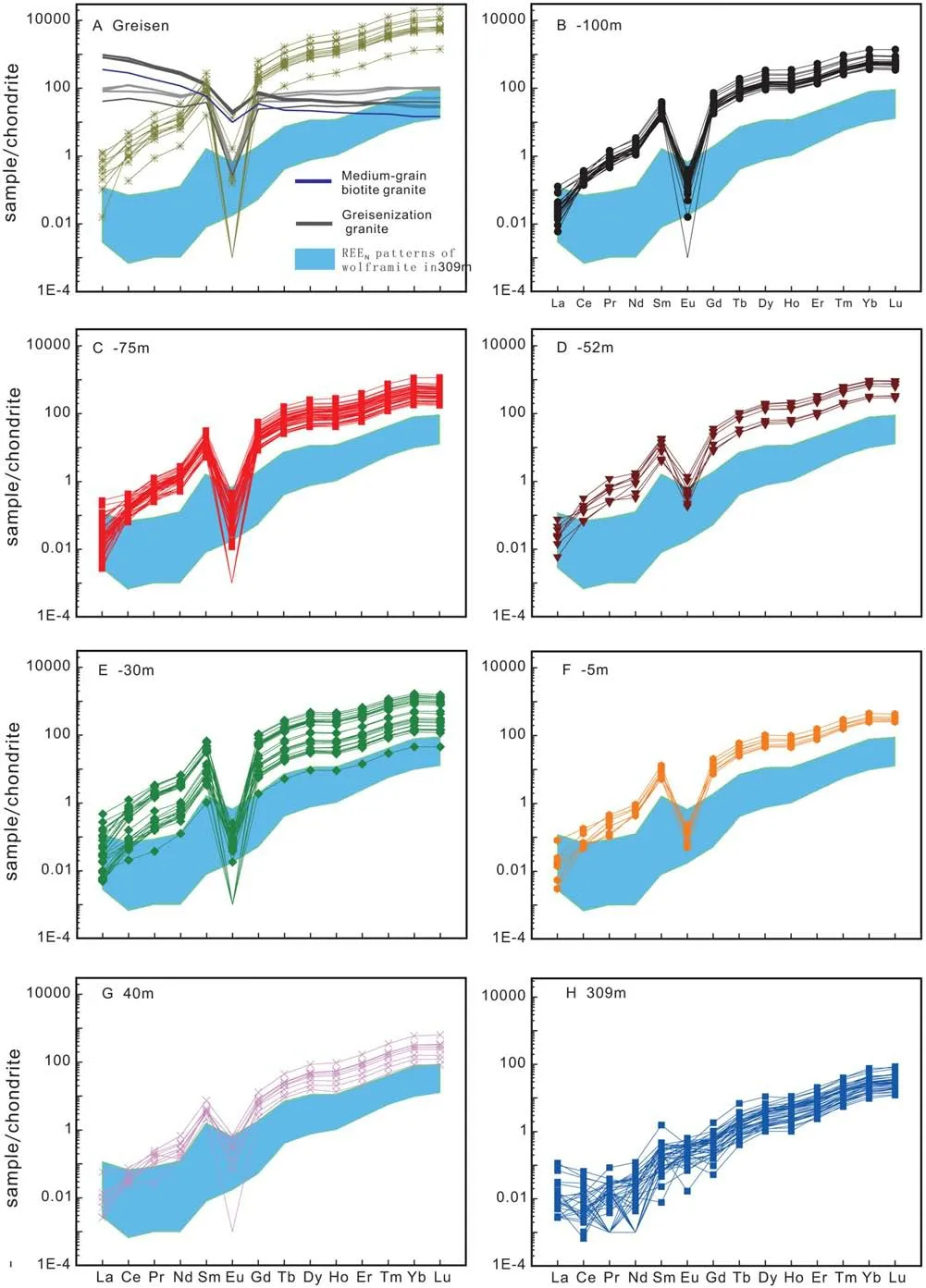
Fig. 11 REE patterns of wolframite in the Maoping deposits. REE values of chondrite are from Taylor and McLennan (1985); REE contents of the greisenized and medium-grain biotite granite in Maoping are from Zhu et al.(2012)
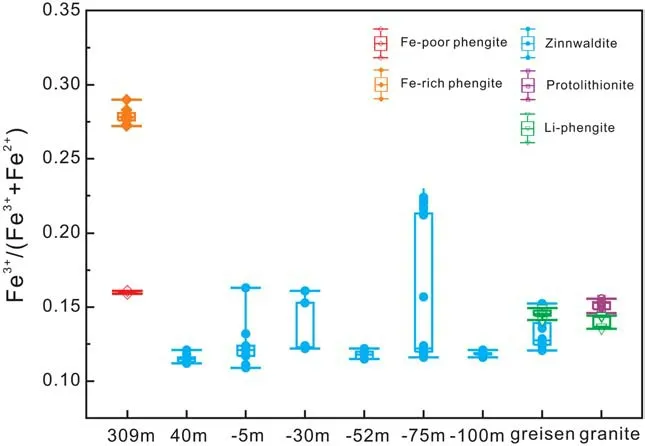
Fig. 12 Variation of Fe 3+/(Fe3++ Fe2+)ratios of micas in different levels at the Maoping deposit
Different from W, Sn, Nb, Ta, and REEs, Zn is a chalcophile element and is sensitive to sulfide saturation.Sphalerite with economic value is mainly distributed in the quartz-veins in the Xiamaoping segment, with levels from ground to - 75 m (No. 2 team of Jiangxi Nonferrous Geological Prospecting 2010). The content of Zn in mica decreases from - 75 m, which is consistent with the precipitation of sphalerite from - 75 m (Fig. 9m), indicating that ore-forming fluids reach sulfide saturation at about- 75 m level. With the precipitation of sphalerite, the content of Zn in the fluid decreases gradually.
7.3 The possible role of fracture system in quartzvein type mineralization
The wolframites in greisen often show the dark core and bright overgrowth in the BSE image. The Nb and Ta contents of the dark domain (Nb = 5900 ppm, Ta = 8190 ppm) are higher than the bright domain (Nb = 4030 ppm,Ta = 5480 ppm),indicating that the dark domain formed at a higher temperature than the bright domain. The bright overgrowth has Nb and Ta higher than wolframite in quartz veins. Thus, the dark domain is possible of magmatic origin, while the bright domain is produced by the early hydrothermal activity. During the emplacement of the magma and the interaction of rock and country rocks, the formation of the fracture system in upper strata would result in depressurization and vapor loss. Ore-forming fluids would fill the fractures quickly.The country rocks of upper strata have a lower temperature so that the heat exchange between the country rocks and fluids filling the fracture would lower the temperature of ore-forming fluids,triggering precipitation of wolframite.
Previous studies have shown that the existence of CO2could favor the transportation of tungsten (Higgins 1980;Wang et al.2020;Wood and Samson 2000).The escape of CO2and the decrease of the pressure of ore-forming fluids would lead to precipitation of wolframite and quartz in the fracture system (Korges et al. 2018). The temperature of fluids in the deep level of the vein systems remains constant, suggesting that the formation of the fracture system and the filling of fluids in fractures are very quick. Due to the quick transportation,the ore-forming fluids do not have strong interaction with country rocks and only generate very thin alteration selvage (generally less than 2 km)along quartz veins. With the decrease of the flow rate of ore-forming fluids in the shallow, recycled meteoric water in strata has been added into the emplacing fluids and changing the temperature and oxygen fugacity of fluids.
In summary, the fracture system can highly affect the emplacement and evolution of ore-forming fluids, leading to the deposition of quartz, wolframite, mica, and sphalerite at different levels. Due to the fast flow rate, the interaction between hydrothermal fluids and country rocks are limited. The variation of the composition, oxygen fugacity of ore-forming fluids are mainly controlled by the precipitation of minerals in fracture system themselves.
8 Conclusions
1. In situ compositions of micas and wolframite from in situ analyses indicate that the ore-forming fluids in the Maoping deposit are mainly of magmatic origin.
2. Brittle fractures control the depressurization and fluid mixing of ore-forming fluids,leading to the wolframite mineralization.
3. The geochemical compositional variation as well as the physicochemical processes of the ore-forming fluids are mainly controlled by the deposition of micas and wolframite during the emplacement and evolution of fluids.
AcknowledgementsThis work is financially supported by the National Key R&D Program of China (2016YFC0600207), Key Program of Natural Science Foundation of China(41830428),and the‘CAS Hundred Talents’’ Project to JF Gao. We are grateful to Dr.Juan Li at the School of Earth Sciences and Engineering, Nanjing University for taking BSE images. We also thank the staff of the Nanjing FocuMS Technology Co. Ltd. for their kind help in in situ LA-ICP-MS analysis. Finally, thanks for Helene Legros, Lili Chen,Guanglai Li, and Zeying Zhu’s help and advice.
Author contributionsAll authors contributed to the conception and design study. Data collection and analysis: GHC and JFG; Methodology: JFG and JJL; Writing, original draft preparation: GHC;Writing,review and editing:JFG,JJL and RQZ.All authors read and approved the final manuscript.
杂志排行
Acta Geochimica的其它文章
- Germanium/silica ratio and trace element composition of Early Cambrian siliceous rocks in Keping:implications for the siliceous rocks’ formation and paleoenvironment interpretations
- Mineralogy and geochemistry of pozzolans from the Tombel Plain, Bamileke Plateau, and Noun Plain monogenetic volcanoes in the central part of the Cameroon Volcanic Line
- Zircon U-Pb geochronology, whole-rock geochemical,and Sr-Nd-Pb isotopic constraints on the timing and origin of Permian and Triassic mafic dykes from eastern North China Craton
- Geotectonic significance of the Neoproterozoic ophiolitic metagabbros of Muiswirab area, South Eastern Desert, Egypt:constraints from their mineralogical and geochemical characteristics
- Contribution of Asian dust to soils in Southeast China estimated with Nd and Pb isotopic compositions
- Geology, geochemistry, fluid inclusions and O-H stable isotope constraints on genesis of the Lake Siah Fe-oxide ± apatite deposit,NE Bafq, Central Iran
